Artillery, Drones, Missiles Will Help FVL Penetrate Air Defenses: FVL CFT
Posted on
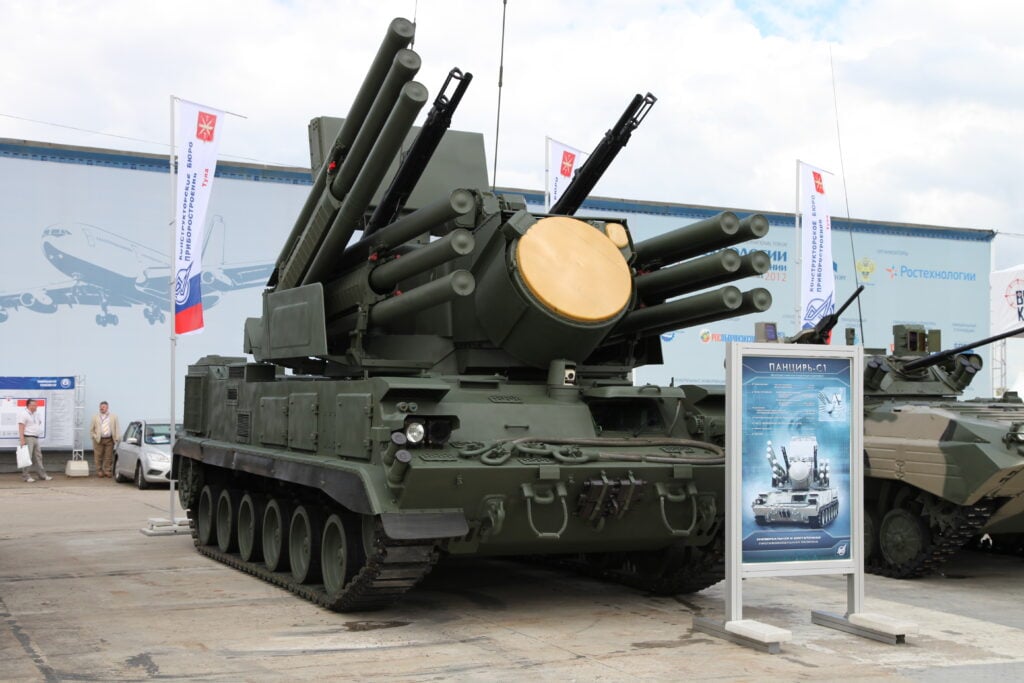
Tracked variant of the Russian Pantsir S1 anti-aircraft missile system (NATO reporting name SA-22 Greyhound)
PENTAGON: “We’re not yielding the air domain to anybody, so we’re going to build those capabilities that we need to dominate,” the head of the Army’s aviation Cross Functional Team told reporters yesterday. While Brig. Gen. Wally Rugen heads what’s officially called the Future Vertical Lift CFT, his portfolio extends well beyond the FVL aircraft program itself. Rugen wants:
- New “modular” missiles with plug-and-play warhead options and longer range;
- New drone designs “purpose built” to penetrate advanced anti-aircraft defenses;
- New manned aircraft — the FVL itself — 60 percent faster than current helicopters, with Artificial Intelligence to assist the human crew.
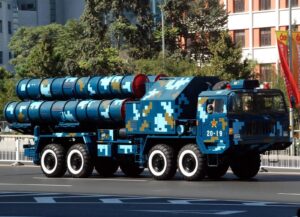
Chinese HQ-9 anti-aircraft missile launcher
All this technology serves a new concept of operations for defeating dense advanced air defenses of the kind Russia and China are both building for themselves and selling abroad. (The term of art is “Anti-Access/Area Denial” or A2/AD, though it’s under assault in some elements of the Pentagon).
Gone are the days of counterinsurgency warfare when the US effortlessly owned the skies and could send slow remote-controlled aircraft like the Predator on long reconnaissance missions or “stack” attack aircraft above a unit they were protecting on the ground. In “contested” airspace, the Army argues, Air Force, Marine, and Navy strike planes may need ground forces to open the way, a concept called Multi Domain Battle. Conversely, the Army needs to revive its artillery to provide Long Range Precision Firepower — the Army’s top modernization priority — even if airstrikes aren’t available.
Speaking to reporters yesterday, Rugen outlined a symbiotic relationship between Army aviation and artillery. Drones jam the enemy radars and locate the anti-aircraft batteries; artillery destroys them with long-range missiles, rockets, and cannon shells; and manned aircraft penetrate the enemy defenses at the resulting weak point. Instead of stacks, where multiple aircraft fly orbits over a single enemy being attacked or a friendly unit being supported, the manned aircraft and drones will stay spread out, coordinating over a network that’s resilient against jamming and hacking — another modernization priority — and using long-range weapons to hit the target from so far away it can’t hit back.
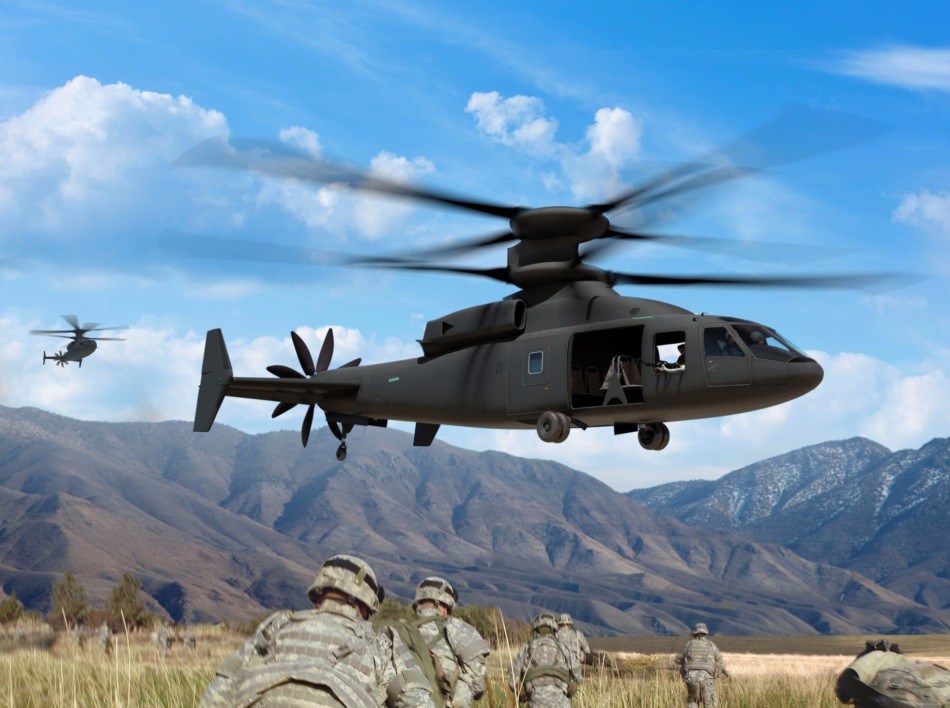
Sikorsky-Boeing SB>1 Defiant
Timelines
How soon can we actually do this? The FVL manned aircraft is still on track to enter service as scheduled in the early 2030s, Rugen said, denying reports of delays. The Army Chief of Staff, Gen. Mark Milley, make a similar denial when he told the Congress last week that “the (Army) Secretary (Mark Esper) and I are not going to stand for delays. It’s an urgent need.”
But, noted our Defense News colleague Jen Judson, who broke the delay story, while the Bell V-280 Valor demonstrator aircraft is already flying, the Sikorsky-Boeing SB>1 Defiant is not and probably won’t until the fall. (The biggest known issue with the Sikorsky-Boeing aircraft, incidentally, is manufacturing its rotor blades, which are much larger and more rigid than Bell’s). Doesn’t that force a delay to do adequate testing?
“What I’ve been told is that they will fly this year, and we’re not at that decision point yet (i.e. to delay or not),” Rugen replied. “We’re not going to make the decision until we have to…. I don’t want to presuppose that they’re not going to make it.” There is a backup plan being “strongly” considered, he said, but he wouldn’t divulge what that is.
In the near term, Rugen’s Cross Functional Team is refining FVL requirements, with Army leadership making key decisions later this year. In the longer term, he said, about two years, the Army needs to decide whether to extend the current Multi-Year Procurement contracts to build existing helicopters — which will expire — or leap ahead to FVL. The decision between the Bell and Sikorsky-Boeing designs will come later, Rugen emphasized.
Ultimately, Rugen noted,, FVL is a joint mega-program where the Army must coordinate every decision with the Office of the Secretary of Defense. The service potentially has a lot more freedom with the other programs in Rugen’s portfolio, the unmanned ones — although he promised to coordinate closely with the other services to avoid duplication on drones.
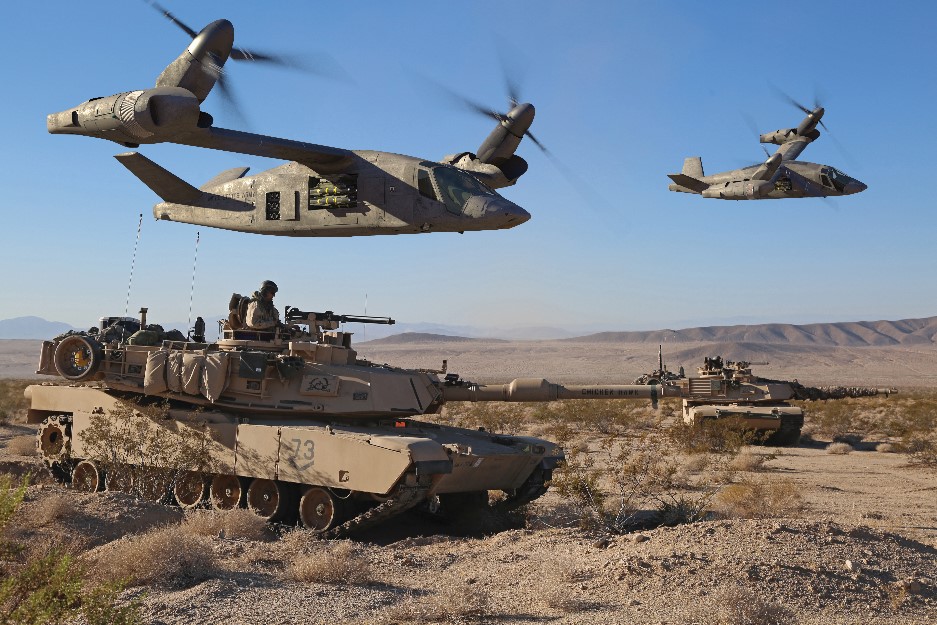
Bell concept art of their V-280 Valor with ground forces
Missiles & Drones
The US military has spent years buying all sorts of drones, slapping cameras on them and maybe Hellfire missiles before flying them in slow orbits in uncontested airspace. That’s got to change, Rugen told reporters. He wants fewer but better drones that are “purpose built” for specific missions in defended airspace.
One size won’t fit all, Rugen emphasized. He envisions four types of unmanned system: a family of modular missiles, two drones in the traditional senses, and one hybrid between missile and drone:
- Modular missiles would have greater range than the current Hellfire and JAGM — about eight kilometers — and plug-and-play warheads “from flares to flechettes,” from anti-aircraft to anti-tank, so the missile can be tailored to the mission, avoiding costly overkill. Blowing up terrorists in a pickup truck doesn’t require the same sophisticated, powerful, costly warhead as killing a tank, Rugen reasons, so if you know you’re hunting pickups, why not have a missile where you can swap in a simpler, cheaper warhead? “The S&T guys have really got a pretty compelling product there,” he said.
- The Future Tactical UAS (Unmanned Aerial Systems) will be assigned directly to Army combat brigades, the way 60-pound RQ-7B Shadows are today. Rugen disdains the term “intelligence, surveillance, and reconnaissance” (ISR) for these drones: The Army talks in terms of Reconnaissance, Surveillance, & Target Acquisition (RSTA), and the new symbiosis between aviation and artillery puts a premium on that “target acquisition” aspect. “We need more than full-motion video,” Rugen said.
- The Advanced UAS will belong to reconnaissance squadrons in Army aviation brigades. Besides RSTA, they would conduct electronic warfare: jamming, spoofing, and decoying enemy sensors. Tactical UAS may do EW too, Rugen said, but that’s not decided. (There’s a long-running battle within the Army over how to revive the EW branch gutted in the 1990s).
- Air-Launched UAS would be mini-drones carried by and launched from larger aircraft, as if they were missiles. Rugen didn’t detail their functions, but given their small size, short range, and low cost relative to ground-launched UAVs, the air-launched UAS seem a natural fit for expendable electronic warfare roles such as decoys.
The Army is conducting an in-depth study of its mix of unmanned aircraft, looking at every branch’s desiderata for drones, Rugen said, but the Cross Functional Team is already moving ahead on unmanned initiatives. “We’re not waiting,” he said. “The magic of the CFTs (is) there’s a lot of stuff done in parallel now,” he said, dramatically accelerating Army modernization.
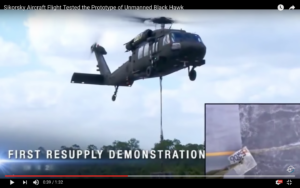
Sikorsky’s experimental unmanned UH-60 Black Hawk
In addition to thoroughbred unmanned systems, the Future Vertical Lift aircraft would be “optionally manned,” with enough artificial intelligence to either assist the human crew or take over entirely. Future pilots might put their aircraft into automated mode over friendly territory as they studied the latest intelligence, then take the controls as they penetrated enemy air defenses. The AI might handle routine tasks so the crew could concentrate on tactics — but take over in an instant if the humans are wounded or knocked out. The Army wants a similar optionally-manned capability for its future ground combat vehicles as well.
For the foreseeable future, though, there will always be a role for the human.
“We need our UAS to do the dangerous and dirty work, but we’re also mindful that an aviator, a soldier, brings a sensor that’s got a 295 degree field of view versus 60, has all the senses versus just one,” Rugen said. “Aviators still have a vital role at the tactical edge.”
Subscribe to our newsletter
Promotions, new products and sales. Directly to your inbox.
